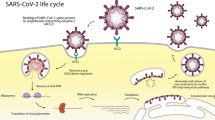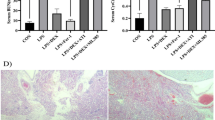Abstract
Objective
Recent evidence suggests a key role of the inflammatory responses in wasp venom-induced acute kidney injury (AKI). However, the potential regulatory mechanisms underlying the inflammatory responses in wasp venom-induced AKI remain unclear. STING reportedly plays a critical role in other AKI types and is associated with inflammatory responses and diseases. We aimed to investigate the involvement of STING in inflammatory responses associated with wasp venom-induced AKI.
Methods
The role of the STING signaling pathway in wasp venom-induced AKI was studied in vivo using a mouse model of wasp venom-induced AKI with STING knockout or pharmacological inhibition and in vitro using human HK2 cells with STING knockdown.
Results
STING deficiency or pharmacological inhibition markedly ameliorated renal dysfunction, inflammatory responses, necroptosis, and apoptosis in wasp venom-induced AKI in mice. Moreover, STING knockdown in cultured HK2 cells attenuated the inflammatory response, necroptosis, and apoptosis induced by myoglobin, the major pathogenic factor in wasp venom-induced AKI. Urinary mitochondrial DNA upregulation has also been observed in patients with wasp venom-induced AKI.
Conclusions
STING activation mediates the inflammatory response in wasp venom-induced AKI. This may offer a potential therapeutic target for the management of wasp venom-induced AKI.







Similar content being viewed by others
Data availability
The datasets generated during and/or analyzed during the current study are available from the corresponding authors on reasonable request.
References
Yang L. Acute kidney injury in Asia. Kidney diseases. 2016;2:95–102.
Hoste EAJ, Kellum JA, Selby NM, Zarbock A, Palevsky PM, Bagshaw SM, et al. Global epidemiology and outcomes of acute kidney injury. Nat Rev Nephrol. 2018;14:607–25.
Gong J, Yuan H, Gao Z, Hu F. Wasp venom and acute kidney injury: the mechanisms and therapeutic role of renal replacement therapy. Toxicon Off J Int Soc Toxinol. 2019;163:1–7.
Han J, Cui L, Yu F, Wang R, Yuan H, Hu F. Megalin blockade with cilastatin ameliorates multiple wasp sting-induced acute kidney injury in rats. Toxicon Off J Int Soc Toxinol. 2022;220: 106960.
Zhang L, Yang Y, Tang Y, Zhao Y, Cao Y, Su B, et al. Recovery from AKI following multiple wasp stings: a case series. Clin J Am Soc Nephrol CJASN. 2013;8:1850–6.
Singh H, Chaudhary D, Dhibar DP. Rhabdomyolysis and acute kidney injury following multiple wasp stings. QJM Monthly J Assoc Physicians. 2021;114:53–4.
Li F, Liu L, Guo X, Luo Z, Zhang Y, Lu F, et al. Elevated cytokine levels associated with acute kidney injury due to wasp sting. Eur Cytokine Netw. 2019;30:34–8.
Tang X, Lin L, Yang YY, Huang RS, Wang BB, Zhang L, et al. Development and validation of a model to predict acute kidney injury following wasp stings: A multicentre study. Toxicon Off J Int Soc Toxinol. 2022;209:43–9.
Yuan H, Lu L, Gao Z, Hu F. Risk factors of acute kidney injury induced by multiple wasp stings. Toxicon Off J Int Soc Toxinol. 2020;182:1–6.
Wang R, Gao D, Yu F, Han J, Yuan H, Hu F. Phospholipase A2 inhibitor varespladib prevents wasp sting-induced nephrotoxicity in rats. Toxicon Off J Int Soc Toxinol. 2022;215:69–76.
Tang WX, Wu WH, Qiu HY, Bo H, Huang SM. Amelioration of rhabdomyolysis-induced renal mitochondrial injury and apoptosis through suppression of Drp-1 translocation. J Nephrol. 2013;26:1073–82.
Song SJ, Kim SM, Lee SH, Moon JY, Hwang HS, Kim JS, et al. Rhabdomyolysis-Induced AKI Was Ameliorated in NLRP3 KO Mice via Alleviation of Mitochondrial Lipid Peroxidation in Renal Tubular Cells. Int J Mol Sci. 2020;21:8564.
Emma F, Montini G, Parikh SM, Salviati L. Mitochondrial dysfunction in inherited renal disease and acute kidney injury. Nat Rev Nephrol. 2016;12:267–80.
Zager RA, Burkhart K. Myoglobin toxicity in proximal human kidney cells: roles of Fe, Ca2+, H2O2, and terminal mitochondrial electron transport. Kidney Int. 1997;51:728–38.
Plotnikov EY, Chupyrkina AA, Pevzner IB, Isaev NK, Zorov DB. Myoglobin causes oxidative stress, increase of NO production and dysfunction of kidney’s mitochondria. Biochem Biophys Acta. 2009;1792:796–803.
Maekawa H, Inoue T, Ouchi H, Jao TM, Inoue R, Nishi H, et al. Mitochondrial damage causes inflammation via cGAS-STING signaling in acute kidney injury. Cell Rep. 2019;29:1261-1273 e6.
Hopfner KP, Hornung V. Molecular mechanisms and cellular functions of cGAS-STING signalling. Nat Rev Mol Cell Biol. 2020;21:501–21.
Wan D, Jiang W, Hao J. Research advances in how the cGAS-STING pathway controls the cellular inflammatory response. Front Immunol. 2020;11:615.
Zhao M, Wang Y, Li L, Liu S, Wang C, Yuan Y, et al. Mitochondrial ROS promote mitochondrial dysfunction and inflammation in ischemic acute kidney injury by disrupting TFAM-mediated mtDNA maintenance. Theranostics. 2021;11:1845–63.
Gong W, Lu L, Zhou Y, Liu J, Ma H, Fu L, et al. The novel STING antagonist H151 ameliorates cisplatin-induced acute kidney injury and mitochondrial dysfunction. Am J Physiol Renal Physiol. 2021;320:F608–16.
Yu F, Cui L, Gao Z, Lu X, Hu F, Yuan H. A rat model of acute kidney injury caused by multiple subcutaneous injections of Asian giant hornet (Vespa mandarina Smith) venom. Toxicon Off J Int Soc Toxinol. 2022;213:23–6.
Brooks C, Wei Q, Cho S, Dong Z. Regulation of mitochondrial dynamics in acute kidney injury in cell culture and rodent models. J Clin Investig. 2009;119:1275–85.
Yuan H, Gao Z, Lu X, Hu F. Role of collectin-11 in innate defence against uropathogenic Escherichia coli infection. Innate Immun. 2021;27:50–60.
Haendeler J, Drose S, Buchner N, Jakob S, Altschmied J, Goy C, et al. Mitochondrial telomerase reverse transcriptase binds to and protects mitochondrial DNA and function from damage. Arterioscler Thromb Vasc Biol. 2009;29:929–35.
Hu F, Liang W, Ren Z, Wang G, Ding G. Surfactant protein D inhibits lipopolysaccharide-induced monocyte chemoattractant protein-1 expression in human renal tubular epithelial cells: implication for tubulointerstitial fibrosis. Clin Exp Immunol. 2012;167:514–22.
Gao Z, Lu L, Chen X. Release of HMGB1 in podocytes exacerbates lipopolysaccharide-induced acute kidney injury. Mediators Inflamm. 2021;2021:5220226.
Rha MS, Jeong HW, Ko JH, Choi SJ, Seo IH, Lee JS, et al. PD-1-expressing SARS-CoV-2-specific CD8(+) T cells are not exhausted, but functional in patients with COVID-19. Immunity. 2021;54(44–52): e3.
Mulay SR, Honarpisheh MM, Foresto-Neto O, Shi C, Desai J, Zhao ZB, et al. Mitochondria permeability transition versus necroptosis in oxalate-induced AKI. J Am Soc Nephrol. 2019;30:1857–69.
Yang Q, Ren GL, Wei B, Jin J, Huang XR, Shao W, et al. Conditional knockout of TGF-betaRII /Smad2 signals protects against acute renal injury by alleviating cell necroptosis, apoptosis and inflammation. Theranostics. 2019;9:8277–93.
Lin Q, Li S, Jiang N, Jin H, Shao X, Zhu X, et al. Inhibiting NLRP3 inflammasome attenuates apoptosis in contrast-induced acute kidney injury through the upregulation of HIF1A and BNIP3-mediated mitophagy. Autophagy. 2021;17:2975–90.
Zhang X, Bai XC, Chen ZJ. Structures and mechanisms in the cGAS-STING innate immunity pathway. Immunity. 2020;53:43–53.
Decout A, Katz JD, Venkatraman S, Ablasser A. The cGAS-STING pathway as a therapeutic target in inflammatory diseases. Nat Rev Immunol. 2021;21:548–69.
Zhang Y, Wang W, Gong Z, Peng Y, Li X, Zhang Z, et al. Activation of the STING pathway induces peripheral sensitization via neuroinflammation in a rat model of bone cancer pain. Inflamm Res Off J Eur Histamine Res Soc [et al]. 2022;72:117–32.
Bai J, Liu F. cGAS-STING signaling and function in metabolism and kidney diseases. J Mol Cell Biol. 2021;13:728–38.
Qi X, Wang J, Fei F, Gao X, Wu X, Shi D, et al. Myricetin-loaded nanomicelles protect against cisplatin-induced acute kidney injury by inhibiting the DNA damage-cGAS-STING signaling pathway. Mol Pharm. 2023;20:136–46.
Skopelja-Gardner S, An J, Elkon KB. Role of the cGAS-STING pathway in systemic and organ-specific diseases. Nat Rev Nephrol. 2022;18:558–72.
Jin L, Yu B, Armando I, Han F. Mitochondrial DNA-mediated inflammation in acute kidney injury and chronic kidney disease. Oxid Med Cell Longev. 2021;2021:9985603.
Luo W, Wang Y, Zhang L, Ren P, Zhang C, Li Y, et al. Critical role of cytosolic DNA and its sensing adaptor STING in aortic degeneration, dissection, and rupture. Circulation. 2020;141:42–66.
Liu J, Jia Z, Gong W. Circulating mitochondrial DNA stimulates innate immune signaling pathways to mediate acute kidney injury. Front Immunol. 2021;12: 680648.
Rabb H, Griffin MD, McKay DB, Swaminathan S, Pickkers P, Rosner MH, et al. Inflammation in AKI: current understanding, key questions, and knowledge gaps. J Am Soc Nephrol. 2016;27:371–9.
Haller H, Bertram A, Nadrowitz F, Menne J. Monocyte chemoattractant protein-1 and the kidney. Curr Opin Nephrol Hypertens. 2016;25:42–9.
Ix JH, Shlipak MG. The promise of tubule biomarkers in kidney disease: a review. Am J Kidney Dis. 2021;78:719–27.
Ning L, Wei W, Wenyang J, Rui X, Qing G. Cytosolic DNA-STING-NLRP3 axis is involved in murine acute lung injury induced by lipopolysaccharide. Clin Transl Med. 2020;10: e228.
Murthy AMV, Robinson N, Kumar S. Crosstalk between cGAS-STING signaling and cell death. Cell Death Differ. 2020;27:2989–3003.
Zheng W, Liu A, Xia N, Chen N, Meurens F, Zhu J. How the innate immune DNA sensing cGAS-STING pathway is involved in apoptosis. Int J Mol Sci. 2023;24:3029.
Chung KW, Dhillon P, Huang S, Sheng X, Shrestha R, Qiu C, et al. Mitochondrial damage and activation of the STING pathway lead to renal inflammation and fibrosis. Cell Metab. 2019;30:784-799 e5.
Funding
This study was supported by grants from the Natural Science Foundation, Hubei Province, China (2022CFD108).
Author information
Authors and Affiliations
Contributions
HY and FH designed the study. YL, LL, and FY conducted the experiments. YL, LL, and ZG analyzed the data and wrote the manuscript. ZG and FH contributed to the revision of the manuscript. All authors read and approved the final version of the manuscript.
Corresponding authors
Ethics declarations
Conflict of interest
The authors declare that they have no competing interests.
Ethics approval
This study was performed in line with the principles of the Declaration of Helsinki. Ethical approval was granted by the Xiangyang Central Hospital Ethics Committee.
Consent to participate
Written informed consent was obtained from all individual patients included in this study.
Additional information
Responsible Editor: Thiago Cunha.
Publisher's Note
Springer Nature remains neutral with regard to jurisdictional claims in published maps and institutional affiliations.
Rights and permissions
Springer Nature or its licensor (e.g. a society or other partner) holds exclusive rights to this article under a publishing agreement with the author(s) or other rightsholder(s); author self-archiving of the accepted manuscript version of this article is solely governed by the terms of such publishing agreement and applicable law.
About this article
Cite this article
Lv, Y., Lu, L., Yu, F. et al. STING deficiency protects against wasp venom-induced acute kidney injury. Inflamm. Res. 72, 1427–1440 (2023). https://doi.org/10.1007/s00011-023-01749-5
Received:
Revised:
Accepted:
Published:
Issue Date:
DOI: https://doi.org/10.1007/s00011-023-01749-5




